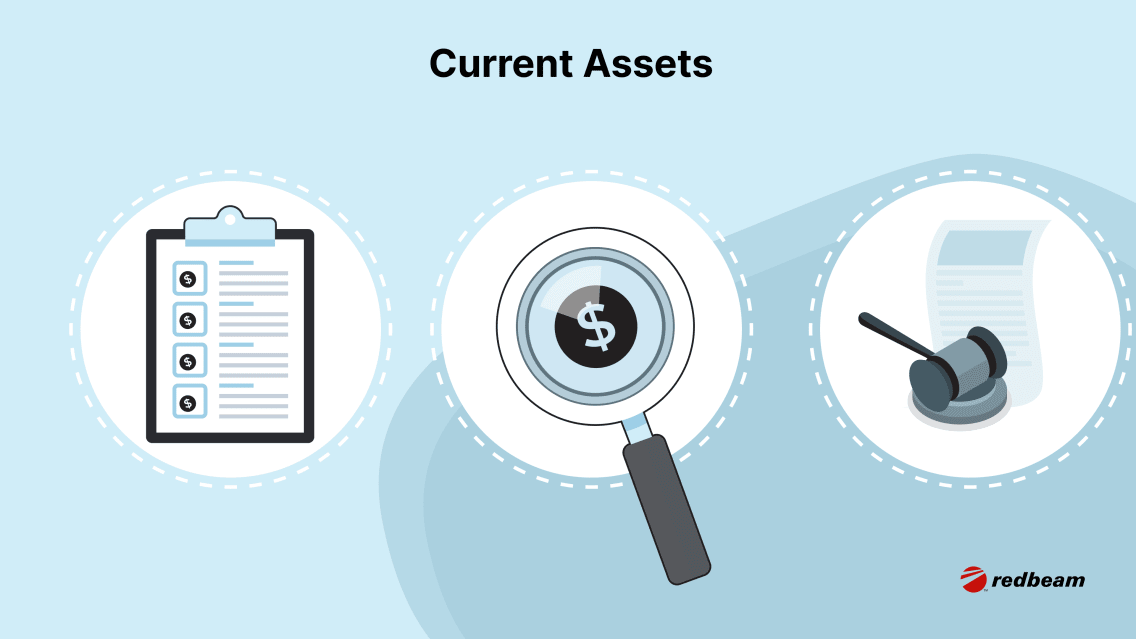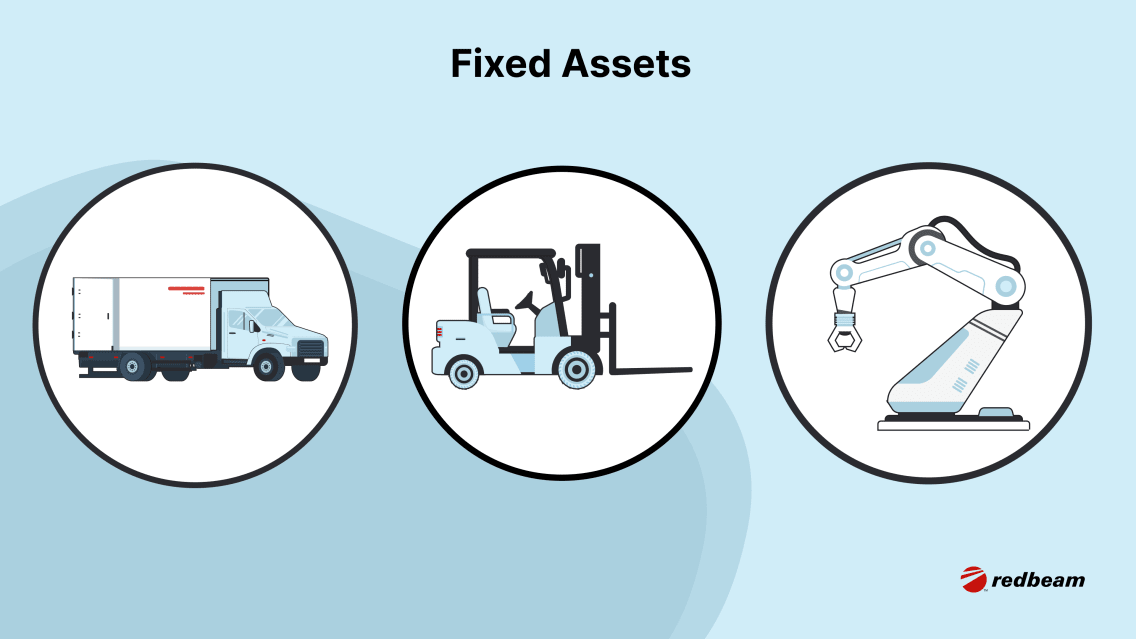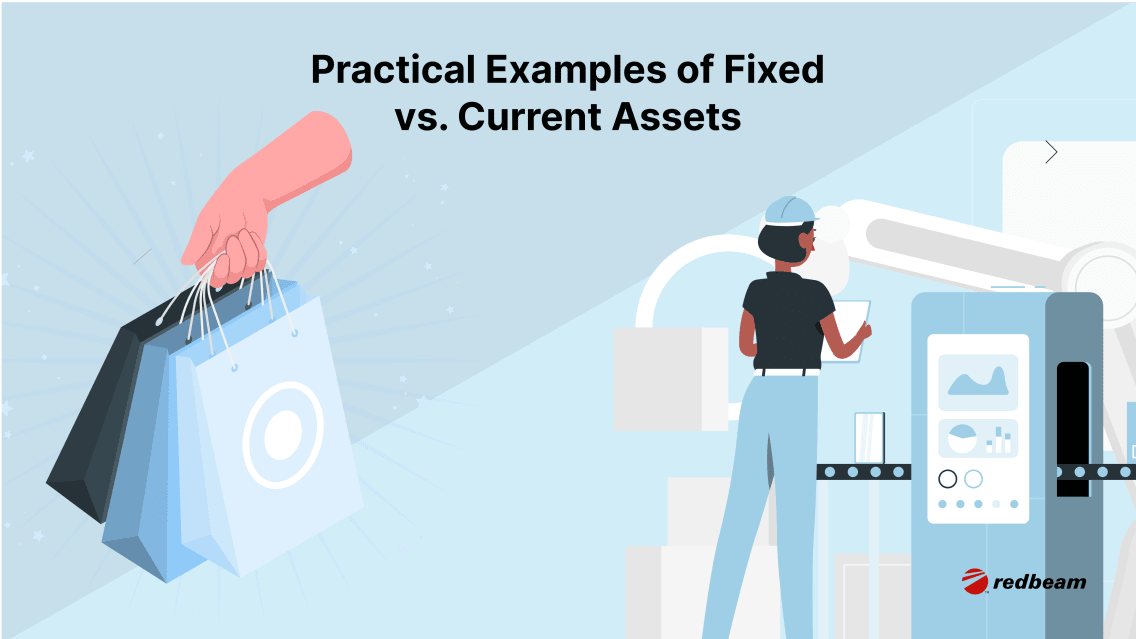Learn the key differences between current and fixed assets and how they impact your business’s financial health. Streamline fixed asset management with RedBeam’s tracking software for real-time visibility and control.
By clarifying the distinctions between current and fixed assets, organizations can optimize their asset tracking strategy or software. For instance, RedBeam's powerful asset tracking software solution offers enhanced visibility and control over fixed assets, but knowing your problem is the first step to finding the right solution.
Whether you’re starting from scratch or looking for a more improved solution for your specific asset tracking needs, this guide provides valuable insights to improve your business's fiscal health and operational efficiency.
Main takeaways from this article:
- Current assets are temporary, highly liquid assets that include cash, inventory, and accounts.
- Fixed assets are permanent or long-term assets such as equipment, IT devices, and tools that can be subject to depreciation over time.
- Understanding how to classify assets can significantly enhance managing them via financial reporting and tracking/assignment.
- RedBeam’s asset tracking solution offers comprehensive management for fixed assets
What Is a Current Asset?

Companies expect to convert current assets to cash or to use them up within one year or the business's operating cycle. Because these items finance daily operations, stock of current assets is a key indicator of a company's short-term financial health and liquidity.
Types of Current Assets
- Cash: The most liquid asset, readily available for use.
- Accounts Receivable: Money owed to the business by customers for goods or services delivered.
- Inventory: Goods available for sale or consumable materials used to produce goods.
- Prepaid Expenses: Payments made in advance for future expenses (e.g., insurance, rent).
- Marketable Securities: Investments that can be quickly converted to cash.
Characteristics of Current Assets
- Liquidity: Either cash or can be quickly converted to cash.
- Short-Term Use: Typically used or converted into cash within one year.
- Essential for Operational Efficiency: They fund daily operational activities and ensuring smooth cash flow.
What Is a Fixed Asset?

Fixed assets are tangible assets that include property or equipment that a business owns and uses in its operations to generate income. Unlike current assets, they are not directly converted to cash, but rather they serve as tools in a company’s operations.
Types of Fixed Assets
- Machinery: Equipment used in the production process.
- IT Devices: Expensive laptops, projectors, tablets etc.
- Vehicles: Company cars, trucks, and other transportation equipment.
- Furniture and Fixtures: Office furniture, lighting, and other permanent installations.
Characteristics of Fixed Assets
- Long-Term Use: Intended for use in the business for more than one year.
- Depreciation: These assets lose value over time through wear and tear, and their cost is spread out over their useful life.
- Change Locations: They often travel to different places within an organization including but not limited to rooms and different personnel throughout the company.
Key Differences Between Fixed and Current Assets
Purpose
Current assets primarily serve to support daily operational needs and ensure a business can meet its short-term financial obligations. They provide the liquidity needed to cover expenses such as payroll, utilities, and inventory purchases.
Fixed assets are intended for long-term use, contributing to a company's infrastructure and production capabilities over several years. These assets, like buildings and machinery, are essential for sustained operations and growth, enabling businesses to produce goods or services and improve efficiency.
Depreciation
Because fixed assets depreciate, they require accurate financial reporting and setting aside funds for future asset replacement. Understanding this truth via a good, fixed asset tracking software supports businesses to better manage their resources and plan for long-term investments more effectively.
Impact on Financial Health
The classification of assets directly influences a company's financial health. Current assets provide a snapshot of short-term financial stability and liquidity, essential for covering immediate expenses. On the other hand, fixed assets reflect long-term investment and potential for sustained growth.
Companies with a balanced mix of both are generally more likely to face economic fluctuations. Effective management of these assets also impacts creditworthiness and investor confidence, shaping the overall financial strategy. Utilizing advanced asset management tools can further enhance financial reporting accuracy and operational efficiency, contributing to a robust financial foundation.

Fixed Assets Examples in Various Industries
Understanding how fixed assets function throughout an organization can reveal current blind spots with asset tracking procedures.
These real-world examples help illustrate how industries leverage their fixed assets for sustained growth and productivity across various industries:
- Manufacturing: Machinery and equipment used in production lines.
- Real Estate: Buildings and land owned by companies. These include office spaces, retail stores, and warehouses. The value of land remains stable, while the value of buildings depreciates.
- Technology: Servers, computers, and other IT infrastructure necessary to maintain software and hardware processes.
How Assets Are Recorded and Reported in Financial Documents
Current and fixed assets should be treated differently in accounting practices in order for stakeholders to make informed decisions. Here's how these assets are documented:
Income Statement
- Current Assets: Current assets don't appear in income statements, since income statements record performance over time while current assets reflect a set point in time.
- Fixed Assets: While fixed assets themselves don't appear on an income statement, fixed asset depreciation does as an expense, reflecting change in value over time. Depending on your industry and business model, you may record fixed asset depreciation under operating expenses, or if the asset relates to production, under cost of goods sold.
Balance Sheet
- Current Assets: Listed on the company's balance sheet under "current assets," these are grouped together and used to calculate liquidity ratios such as the current and quick ratios.
- Fixed Assets: Shown under "non-current assets" on the balance sheet, fixed assets are recorded at their acquisition cost and then reduced by accumulated depreciation to determine net book value.
Managing Current and Fixed Assets
Whereas current assets are often tracked by an accountant, fixed asset tracking is handled by operational staff in the field. As fixed assets such as equipment are handled by personnel, organizations need visibility into the movement and wear on the equipment. Investing in a dedicated asset tracking software, organizations can deploy manual or automated tracking solutions via barcodes or Radio Frequency Identification.
Here's a detailed look at why proper asset management is crucial for business success:
- Operational Efficiency: Managing assets effectively ensures that resources are used optimally. This reduces wastage and operational costs while enhancing productivity.
- Regulatory Compliance: Proper asset management ensures that the organization adheres to financial regulations and standards, avoiding any legal issues and potential fines.
- Better Investment Decisions: By clearly understanding current and fixed assets, companies can make smarter investment choices, allocate resources more effectively, and plan for long-term growth.
- Improved Liquidity: Effective management of current assets, like cash and inventory, is important for maintaining liquidity and swiftly meeting short-term obligations.
- Risk Management: Proper documentation and tracking of assets help mitigate risks related to asset loss, theft, or depreciation, ensuring that the company is protected against unforeseen events.
- Avoiding Reporting Errors: Accurate asset tracking helps you avoid tax reporting errors, saving you from wasted labor making corrections, extra auditing expenses, and tax and compliance penalties.
- Competitive Advantage: Efficient asset management gives you a competitive edge by increasing your productivity and helping you fulfill customer orders more quickly.
Common Mistakes in Asset Classification
- Not Updating Asset Records Regularly
Mistake: If you rely on manual updates or spreadsheets, you run a higher risk of failing to update your records in a timely manner, which can undermine your accounting accuracy, cost you deductions you overlooked, and leave you vulnerable to supply shortages.
Solution: Use cloud-based asset management software integrated with barcodes or radio frequency identification to update your asset information automatically.
- Ignoring Asset Depreciation
Mistake: Forgetting to record depreciation can cost you tax deductions, increase your tax liability, and inflate the value of your assets on your balance sheet.
Solution: Make depreciation recording part of your standard operating procedures, using asset management software to automate depreciation calculations.
- Misclassifying Fixed Assets as Expenses
Mistake: Listing fixed assets as expenses can make your income statements inaccurate.
Solution: Record fixed assets on your balance sheet under noncurrent assets or property, plant, and equipment (PP&E), and leave them off your income statement.
- Neglecting Asset Disposal and Write-Offs
Mistake: If you forget to record asset disposals and write-offs, you could be inflating your assets, distorting your balance sheet and costing you depreciation deduction opportunities.
Solution: Record revenue gains or losses from asset disposals and write-offs on your income statement and update your balance sheet to reflect removal of the asset, using asset management software to automate your updates.
Manage Your Assets with RedBeam
RedBeam's comprehensive fixed asset tracking solution is designed to streamline your asset management process, offering greater visibility and control over your physical assets. Capture asset location, status, custom fields etc. manually or automatically with RedBeam. Our platform provides robust features, including multi-tenancy and seamless integration with existing systems.
Ready to experience the benefits of RedBeam firsthand? Schedule a demo today!
Current vs. Fixed Assets FAQs
What Are Some Examples of Current Assets and Fixed Assets?
Current assets include cash, accounts receivable, inventory, and short-term investments. Fixed assets are long-term resources such as land, buildings, machinery, vehicles, and equipment.
What Are Fixed Assets and Current Assets Categorized as on the Balance Sheet?
On the balance sheet, fixed assets are categorized as non-current assets, reflecting long-term use. Current assets are short-term assets expected to be converted into cash within one year.
Are Net Fixed Assets the Same as Current Assets?
No, net fixed assets refer to the value of fixed assets after depreciation. Current assets, however, are short-term assets expected to be converted to cash within a year.


-3.png?width=2000&name=Untitled%20design%20(1)-3.png)






